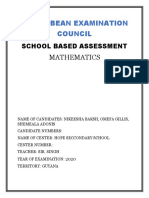INF113 Jul2020
INF113 Jul2020
Uploaded by
AmmarCopyright:
Available Formats
INF113 Jul2020
INF113 Jul2020
Uploaded by
AmmarOriginal Title
Copyright
Available Formats
Share this document
Did you find this document useful?
Is this content inappropriate?
Copyright:
Available Formats
INF113 Jul2020
INF113 Jul2020
Uploaded by
AmmarCopyright:
Available Formats
DEPARTMENT OF INFORMATICS
INFORMATICS 113
EXAM FORMAT: ONLINE DATE: 15 July 2020
Examiners : Prof M Turpin
Time : 120 min
: Prof M Matthee
Moderator / External Examiner : Prof Hanlie Smuts Marks : 40
Student Number Surname Initials
Module outcomes (as in Study Guide)
Question / Section Marks allocated Maximum mark
MO1 MO2 MO3
1-5 (MCQ) 4 6 10
6 10 10
7 5 5
8 2 2
9 6 6
10 3 3
11 4 4
CT PS DT
Total 40
Instructions
1. This paper consists of 2 sections and 11 questions.
2. Answer all the questions – there are no optional questions.
3. This is an open book examination. You may refer to your study notes or textbook.
4. Type your answers in the online format presented.
5. Structure your answers logically.
INF113 – 2020 © UP: Exam 1/4
"The University of Pretoria commits itself to produce academic work of integrity. I affirm that I am aware
of and have read the Rules and Policies of the University, more specifically the Disciplinary Procedure
and the Tests and Examinations Rules, which prohibit any unethical, dishonest or improper conduct
during tests, assignments, examinations and/or any other forms of assessment. I am aware that no
student or any other person may assist or attempt to assist another student, or obtain help, or attempt to
obtain help from another student or any other person during tests, assessments, assignments,
examinations and/or any other forms of assessment."
SECTION A – MULTIPLE CHOICE QUESTIONS (10)
Questions 1 and 2: Critical thinking (4)
Which of the following two claims is stronger?
a) Polar bears will be extinct by the middle of the century.
b) Polar bears are an endangered species.
Consider the following claim: The Nile River is the longest river in Africa
This claim is a:
a) Value Judgement
b) Opinion
c) Fact
d) Recommendation
Question 3: Analytical problem solving (2)
If the number pattern 3, 9, 15, 21, 27, … is continued, which of these numbers is in the sequence:
a) 53
b) 65
c) 39
d) 74
e) 55
Questions 4 and 5: Computational thinking (4)
What is computational thinking?
a) Using computers to solve problems
b) The thinking processes needed to solve problems in a systematic way
c) Giving instructions to a computer
Which of the following is an example of computational thinking?
a) Planning the most effective route from work to home keeping in mind the errands to run as well;
b) Asking Google Maps to give you the shortest route from work to home.
c) When going to a lecture hall for the first time, wander around until you find it.
INF113 – 2020 © UP: Exam 2/4
SECTION B – ESSAY TYPE QUESTIONS (30)
Question 6: Critical Thinking: Argument evaluation (10)
Whom would you prefer as your teacher? Someone who just managed to pass a degree examination
thirty years ago and has never opened a book since, or someone who is fascinated by his subject and
has read widely in it, but left university without taking a degree because the teaching and the course
were boring and he wanted to be free to pursue topics that interested him? This shows that possession
of a university degree is no guarantee that someone will be a good teacher.
The rapid changes in knowledge mean that a university education quickly becomes out of date.
Furthermore, most graduates will readily admit that they have forgotten nearly everything they learned at
university. The only way a degree could be a reliable indication of competence in a subject would be if
degrees had a time limit built into them and needed to be updated every five years in order to remain
valid. Under the present system they mean nothing.
In addition, experts are often bad teachers, because they think that their task is to pass on their
knowledge to their students. That approach to education belongs firmly in the past. Education is about
learning, not teaching, and the knowledge required to pass an exam is more reliably available from
textbooks specially written for the exam and from the internet than from the fallible memory of the
teacher.
Some people may suggest that teachers need paper qualifications in order to show that they have been
taught how to teach, but any teacher knows that is not true. Either you can teach or you cannot, If you
can, you do not need anyone to show you how to do it, and if you cannot, then no amount of guidance or
instruction will turn you into an effective teacher.
The only qualification required to be a teacher should therefore, be the ability to enable students to pass
their exams. Such a change from paper qualifications to a focus on skills would be consistent with
current trends, since most employers are not far more interested in the abilities which potential recruits
have to offer rather than their academic qualifications.
6.1 Using the exact word from the passage as far as possible, identify the main conclusion. (1)
6.2 Using the exact words from the passage as far as possible, identify three intermediate
conclusions.(3)
6.3 State an implicit assumption required if the reasoning in paragraph 3 is to support the main
conclusion. (2)
6.4 Respond to this argument with further argument. (4)
Question 7: Graphs and Stats (5)
The table shows the results of a questionnaire, asking the five schools in a town the proportion of pupils
using the feeding scheme in grade 1, 2, 3 and 4.
School Percentage of pupils using the feeding scheme per grade
1 2 3 4
School A 13 25 42 20
School B 5 18 55 22
School C 24 36 28 12
School D 16 18 61 5
School E 10 14 48 28
7.1 Which school has the most kids (in grade 1 – 4) on the feeding scheme? (1)
INF113 – 2020 © UP: Exam 3/4
7.2 The local newspaper added the numbers of each grade together and divided by five to work out the
percentages for kids in grade 1 – 4 in the five schools. By using this method the newspaper reported
the following percentages: grade 1: 10.4%, grade 2: 18.6%, grade 3: 34.6 % and grade 4: 16.4%.
They forgot to include one of the schools in calculating these percentages. Which school is it?
Explain your answer. (3)
7.3 Will the method followed by the newspaper give an accurate reflection of the percentages of pupils
per grade using the feeding scheme? Explain your answer. (1)
Question 8: Problem solving (2)
Give your own, new example of a mess related to student life.
Question 9: Soft Systems Methodology (6)
Consider the messy problem of resuming basic education (primary and high schools) in South Africa
under lockdown. Develop a root definition for the following stakeholder group by using the CATWOE
mnemonic:
- Teacher unions
Question 10: Critical Thinking: Application (3)
Explain how you will use critical thinking to identify fake news.
Question 11: Design Thinking: application (4)
List four advantages that design thinking has to a systems analyst.
END OF EXAM
INF113 – 2020 © UP: Exam 4/4
You might also like
- MATHS 108 - 2024 Semester Two - Course OutlineNo ratings yetMATHS 108 - 2024 Semester Two - Course Outline6 pages
- Intermediate-statistics-for-Economics-Econ006No ratings yetIntermediate-statistics-for-Economics-Econ0065 pages
- Syllabus Financial Modeling 22.08.2022 FINAL0% (1)Syllabus Financial Modeling 22.08.2022 FINAL7 pages
- BASTX1A BASTY1A - Statistics Learner Guide 2024No ratings yetBASTX1A BASTY1A - Statistics Learner Guide 202470 pages
- Intermediate Statistics For Economics Econ006No ratings yetIntermediate Statistics For Economics Econ0065 pages
- Difficulties in Learning and Teaching Statistics Teacher ViewsNo ratings yetDifficulties in Learning and Teaching Statistics Teacher Views12 pages
- Math 2412 Precalculus TSC Dual Syllabus 19-20No ratings yetMath 2412 Precalculus TSC Dual Syllabus 19-207 pages
- BM6400: Statistics and Data Analysis For Managers: Course DescriptionNo ratings yetBM6400: Statistics and Data Analysis For Managers: Course Description5 pages
- Research Methods: University of Macau Faculty of Business Administration Department of Management and Marketing MGMT3004No ratings yetResearch Methods: University of Macau Faculty of Business Administration Department of Management and Marketing MGMT30045 pages
- Applied Multivariate Statistical AnalysiNo ratings yetApplied Multivariate Statistical Analysi9 pages
- Unit Guide: Mat102 Statistics For Business Trimester 3 2021No ratings yetUnit Guide: Mat102 Statistics For Business Trimester 3 202112 pages
- Tutorial Letter 101/3/2018: The Explanation of CrimeNo ratings yetTutorial Letter 101/3/2018: The Explanation of Crime35 pages
- Prelim Examination - Math in The Modern World100% (1)Prelim Examination - Math in The Modern World2 pages
- PRELIM EXAMINATION - Math in The Modern WorldNo ratings yetPRELIM EXAMINATION - Math in The Modern World2 pages
- Intermediate Statistics For Economics DSC 6 Econ006No ratings yetIntermediate Statistics For Economics DSC 6 Econ0065 pages
- Motivating for STEM Success: A 50-step guide to motivating Middle and High School students for STEM success.From EverandMotivating for STEM Success: A 50-step guide to motivating Middle and High School students for STEM success.No ratings yet
- Performance Task in Practical Research 1 - Group 2 MapanagutanNo ratings yetPerformance Task in Practical Research 1 - Group 2 Mapanagutan42 pages
- Group 6 Part Vi Katrina Annielen M. AbrigoNo ratings yetGroup 6 Part Vi Katrina Annielen M. Abrigo16 pages
- Argumentative Essay On Showing Violent Sports On TV Should Be Stopped As It Desensitizes People Especially ChildrenNo ratings yetArgumentative Essay On Showing Violent Sports On TV Should Be Stopped As It Desensitizes People Especially Children1 page
- Personal Statement - University of EssexNo ratings yetPersonal Statement - University of Essex2 pages
- Ocial Cience: Best News Yet On The Six-Factor Model of Well-BeingNo ratings yetOcial Cience: Best News Yet On The Six-Factor Model of Well-Being17 pages
- Conflict Management: Presented By: Group 3: Meenakshree Nanda Madhuri ChaturvediNo ratings yetConflict Management: Presented By: Group 3: Meenakshree Nanda Madhuri Chaturvedi17 pages
- The Impact of Excessive Use of Gadgets On The Academic PerformanceNo ratings yetThe Impact of Excessive Use of Gadgets On The Academic Performance9 pages
- Difficulties in Learning and Teaching Statistics Teacher ViewsDifficulties in Learning and Teaching Statistics Teacher Views
- BM6400: Statistics and Data Analysis For Managers: Course DescriptionBM6400: Statistics and Data Analysis For Managers: Course Description
- Research Methods: University of Macau Faculty of Business Administration Department of Management and Marketing MGMT3004Research Methods: University of Macau Faculty of Business Administration Department of Management and Marketing MGMT3004
- Unit Guide: Mat102 Statistics For Business Trimester 3 2021Unit Guide: Mat102 Statistics For Business Trimester 3 2021
- Tutorial Letter 101/3/2018: The Explanation of CrimeTutorial Letter 101/3/2018: The Explanation of Crime
- Intermediate Statistics For Economics DSC 6 Econ006Intermediate Statistics For Economics DSC 6 Econ006
- Science: For NTSE, olympiads & competitive examsFrom EverandScience: For NTSE, olympiads & competitive exams
- Motivating for STEM Success: A 50-step guide to motivating Middle and High School students for STEM success.From EverandMotivating for STEM Success: A 50-step guide to motivating Middle and High School students for STEM success.
- Performance Task in Practical Research 1 - Group 2 MapanagutanPerformance Task in Practical Research 1 - Group 2 Mapanagutan
- Argumentative Essay On Showing Violent Sports On TV Should Be Stopped As It Desensitizes People Especially ChildrenArgumentative Essay On Showing Violent Sports On TV Should Be Stopped As It Desensitizes People Especially Children
- Ocial Cience: Best News Yet On The Six-Factor Model of Well-BeingOcial Cience: Best News Yet On The Six-Factor Model of Well-Being
- Conflict Management: Presented By: Group 3: Meenakshree Nanda Madhuri ChaturvediConflict Management: Presented By: Group 3: Meenakshree Nanda Madhuri Chaturvedi
- The Impact of Excessive Use of Gadgets On The Academic PerformanceThe Impact of Excessive Use of Gadgets On The Academic Performance

























































































